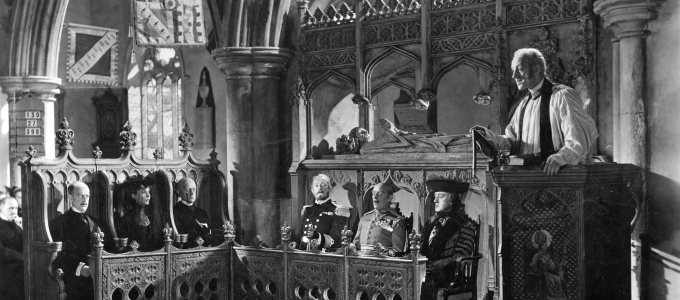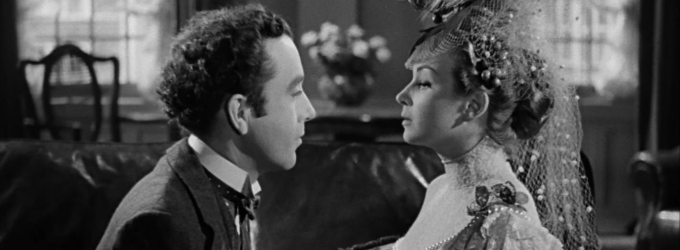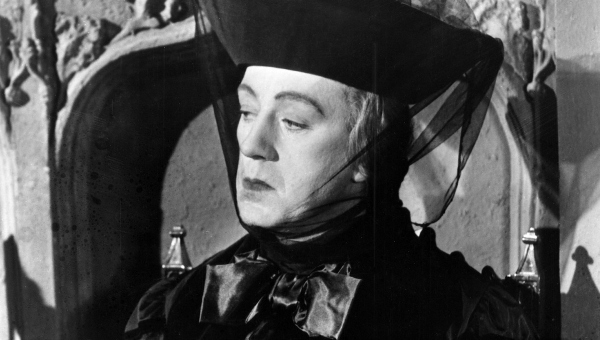
The order of the title cards suggests strongly that Ealing considered Dennis Price [OSCAR WILDE, VICTIM] to be the male star of KIND HEARTS AND CORONETS (Robert Hamer, 1949) but in retrospect a comic turn by Alec Guinness, [OLIVER TWIST, THE BRIDGE ON THE RIVER KWAI, LAWRENCE OF ARABIA, DOCTOR ZHIVAGO, A PASSAGE TO INDIA] as the eight wildly eccentric D’Ascoynes dispatched variously throughout the film, has become a star turn. And the serene twinkle of top–billed Valerie Hobson [GREAT EXPECTATIONS] as the upright and reserved Edith is lost in the bright moonlight of unashamed, unflappable, unstoppable Sibella, played with supreme moral fluidity by Joan Greenwood [WHISKY GALORE, THE MAN IN THE WHITE SUIT, THE IMPORTANCE OF BEING ERNEST].
Guinness was Sir Alec’s mother’s best guess as to his father’s name, and according to Piers Paul Read’s biography, one member of the great banking–and–stout dynasty did publicly acknowledge him as some sort of cousin. Ironic, then, that he should play the aristocratic D’Ascoynes, hunted down by Price’s frustrated Louis—he rejected by the family after his D’Ascoyne mother married his Italian singer father—in order to secure his own position as Duke of Chalfont.
Ealing excelled at this sort of gentle mockery (if serial killing can be gentle)
Made in 1949, KIND HEARTS is an adaptation of Roy Horniman’s 1907 novel Israel Rank: the Autobiography of a Criminal, in which a aristocratic lady marries an itinerant Jew, is spurned by her family, has a son who then proceeds to hunt down…well, you get the idea. Advocates for this largely forgotten and difficult to obtain novel assert that it is a biting satire on the deranged excesses of Edwardian anti-Semitism. By contrast, critics observe that it may be the kind of satire so subtle that one could mistake it for the thing it seeks to condemn. Either way, 1949 was not the time to be making films about Jewish characters murdering their way into the ruling class of Britain (and along the way seizing control of a bank). Italians, though, fair game apparently: Israel Rank becomes Louis Mazzini, the horror factor of some of the D’Ascoyne murders is toned down, and it all becomes much more palatable. Ealing excelled at this sort of gentle mockery (if serial killing can be gentle) of British institutions and here the pre–war ruling class is roundly condemned, in a seemingly inoffensive fashion that packs a hidden punch.
Many people in Britain are pleased to live in Victorian houses, although they are less pleased when any repairs or alterations are needed and they discover just how poorly built those tend to be. You have to go to the Edwardians for build quality. One theory is that the Victorians couldn’t quite believe their luck, as the second industrial revolution took hold and the Empire grew seemingly without constraint, so they tended to throw up new buildings in a speculative rush. But the Edwardians believed they had secured their place as the natural rulers of the world, and they built for the ages. Astonishingly pompous office buildings, palatial railway stations and banks, impregnable fortresses of commerce and governance rising up like cliffs above great suburban seas of solid bourgeoisie homes resembling country houses that shrank in the wash. Of course, the high points on a curve have a downturn following them, and we can look back and see that golden decade, or dozen years, or however you view it, as the beginning of the end of Britain’s dominance of the world—a decline which has continued fairly steadily over the last century. KIND HEARTS lays bare the hard, cold, dried–out heart of the Edwardian ruling class, revealing the rotten, cant–filled, arrogant, dismissive and high–handed core of a degenerate system.
Each of Guinness’s characters illustrates a failure of the hereditary ruling class. They are variously arrogant and abusive, useless and deluded, pompous, self–indulgent, priggish or idiotic, but most of all they are serenely sure of their un–earned and un–justified position. Thus we are brought to sympathise with Louis as he works his way through them, poisoning here and exploding there, drowning and shooting. Each victim is dispatched in a fashion ironically fitting to their particular brand of obnoxiousness. Throughout the film, everyone is spectacularly over–dressed in a way that seems arch and theatrical today, but which must have been downright offensive in a post–war Britain still gripped by rationing. Louis’ outfits in particular become more and more garishly outré as he nears the dukedom. In prison, convicted of murder for the one death he didn’t cause, at a time when wealthy or aristocratic prisoners were given very easy treatment, he luxuriates in a smoking jacket while exchanging badinage with the governor and his staff.
Louis the charming, Louis the sophisticated beyond his station, Louis the resourceful and inventive manipulator and murderer, could be seen as an early exemplar of the ubiquitous “cultured serial killer” character in twentieth century fiction. Imagine Hannibal, Tom Ripley and Louis, lolling around at a high-society reception, or maybe in their private box at the opera. Imagine them perhaps exchanging notes on a exquisite tailoring, fine dining and how best to dispose of a freshly dead aristocrat. Nobody knew what a “psychopath” was in 1907. At least, they didn’t know what to call them. And even by 1949 it was still a relatively novel idea amongst professionals. And Louis is not ill, not in the way that his contemporary counterparts are ill. Louis is, more than anything, angry and insulted. His plot to dispatch the D’Ascoynes is cold and meticulous, but it is goal–oriented and self–limiting; albeit driven by a towering hubris and all–consuming narcissism. But he isn’t on the rampage; in fact, he has excellent impulse control. One does wonder quite how he planned to fill the day, once he became Duke of Chalfont.
The performances are filled with such brio and panache that we can overlook the odd wobbly flat…
Cinema–goers are used to serial killers now: we take them in our stride, we understand them very well—or think we do. But Louis wasn’t abused, he isn’t the product of a terrible secret nightmare and he wasn’t made by an unspeakable horror. He was made by the casual disregard and lazy cruelty of a ruling class who viewed the great mass of people as meaningless and valueless, beneath notice. A class who reserved their greatest contempt for those who were born into high society and rejected it. Louis is straightforwardly wicked (after all, he does kill people both for personal gain and with a certain amount of relish, once he gets his hand in) but at the same time he sees all too clearly how the society into which he is born works and identifies a route to a higher station within it—by using the very rules of un–earned privilege against that system.
And this in 1949. Between the writing of the novel and the making of the film, the Edwardian ruling class had blundered into the First World War and afterwards been shamed into giving the vote to working class men and upper class women; they’d seen a Labour government in power by mistake; they’d then driven the world economy into a brick wall at full speed during the Great Depression; they provided the Second World War for their children and grand-children to fight in, and now in their dotage were faced with Clem Atlee and the NHS. “Where did it all go wrong?”, they must have wondered.
KIND HEARTS has one last sting in the tail…
KIND HEARTS is funny, witty and wicked but also sly and knowing. It gives us important clues about just where the problem lay, where the rot set in. The performances are filled with such brio and panache that we can overlook the odd wobbly flat or some iffy work with miniatures; but we also might overlook the radical message behind the quilted satin: good riddance to bad rubbish! But, KIND HEARTS has one last sting in the tail. It was made at a time when villains couldn’t really be seen to have got away with it, and Louis finds himself caught in a dilemma. He must choose between the beautiful but distant Edith, living symbol of his triumph over the D’Asgoynes, and Sibella, the childhood sweetheart who’s become every bit the match for him in guile and steely determination. He must choose between the success of his plan and straightforward happiness. But the plan has lead to a hollow and sterile sort of success, whereas happiness would lead him back into the grubby, common (if comfortable) world he sought to escape. For Louis is no working-class hero: his exposure of the aristocracy is a side effect of his burning desire for its acceptance.
Contemptuous of the individual D’Asgoynes as he is, he longs to be recognised as one in general terms. He cannot be a symbol of hope for us;rather he stands for the capability of the ruling class to co-opt its enemies. Maybe he’ll be better off if he does expose his own crimes, and bring destruction down upon himself. And where does that leave us, you and me? What prison gates do we stand before, pondering whether our history is about to catch up with us? What do we choose?
httpvh://www.youtube.com/watch?v=fYTxIw6kjZ0

